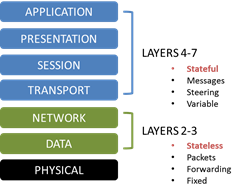SDN Prerequisite: Stateful versus Stateless
#SDN #SDAS #cloud Things you need to know before diving into SDN...
We've talked before about the bifurcation of the network, which is driven as much by the evolution of network services from "nic...

Published Apr 21, 2014
Version 1.0Lori_MacVittie Employee
Employee
 Employee
EmployeeJoined October 17, 2006
Lori_MacVittie Employee
Employee
 Employee
EmployeeJoined October 17, 2006
Bruno_9488 Nimbostratus
Nimbostratus
Apr 21, 2014 Nimbostratus
NimbostratusHello Lori
I partially disagree with your conclusion about SDN vs state(less) as there are a number of cases where controllers have been used to manage large scale states in networks.
As you may know, controllers are not new to networking, they have been there in voice networks, ATM networks, optical networks, etc. In the case of cellular networks, all the services from basic phone features to being able to roam is possible because portions of the IMS, acting as a controller, manage state for my mobile device. Considering the number of cellular devices out there, it is safe to conclude the IMS, as a controller, handles large amount of state.
Now that being said what you are hinting at is "where" should different type of state be maintained. For instance a firewall rule has no state until implemented on a device and once traffic flow through it, that becomes the only place that state is maintained. Should it report its states to a central controller ? There would have to be some benefits to do so a bit like my IMS example... For instance to possibly solve active / active asynchronous connectivity to 2 DC (a bit like the ASM policy synch between DCs but with state on top...) or some form of active correlation of sessions between diverse enforcement points which currently are acting as "ships in the night" and cannot be coordinated. (not implying these are good use cases).
Today we tend to solve these issues by aggregating the traffic to a small set of perimeter devices, reducing the use case to a simpler one as all the state reside on one or few devices. SDN opens the possibility of similar benefits in a distributed architecture.
This is not a binary discussion and again, current networking technologies have shown that controllers functions can indeed maintain large scale state if there is a need for it and if this is the case, well we build the appropriate types of controllers for the job.
Cheers
Bruno
Help guide the future of your DevCentral Community!
What tools do you use to collaborate? (1min - anonymous)